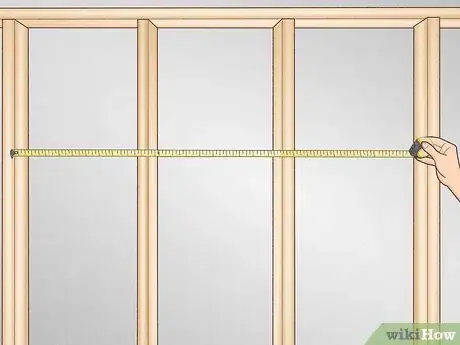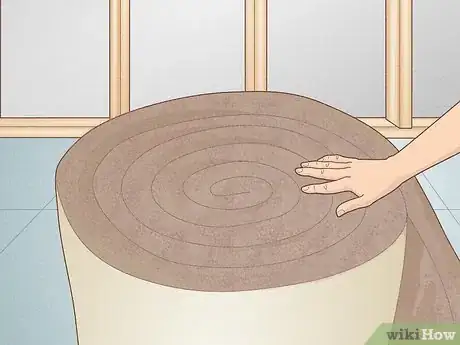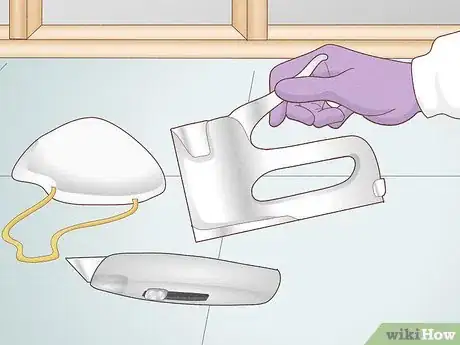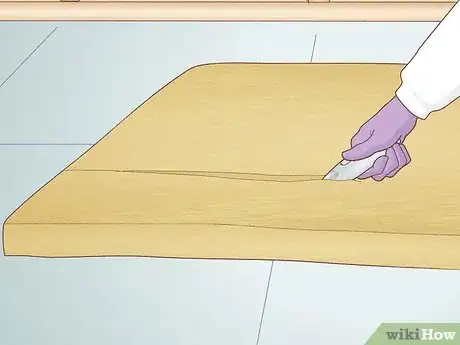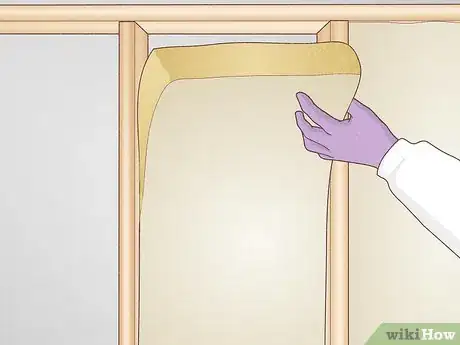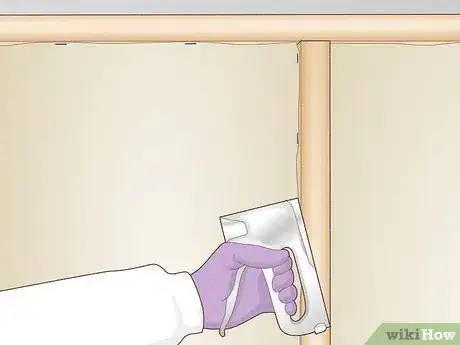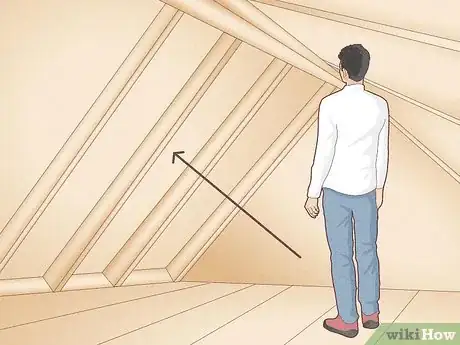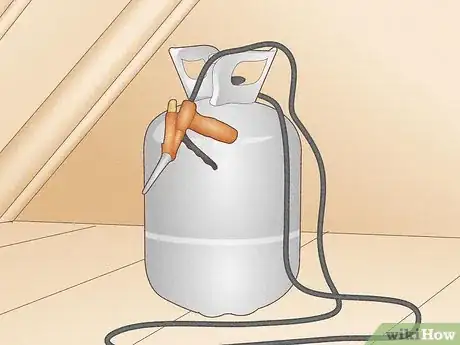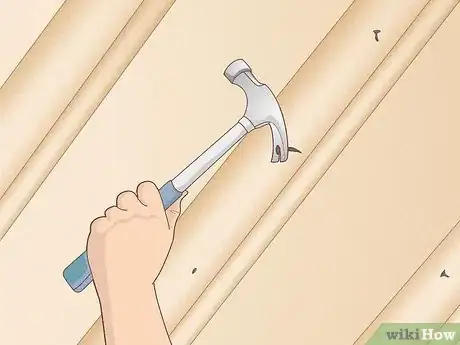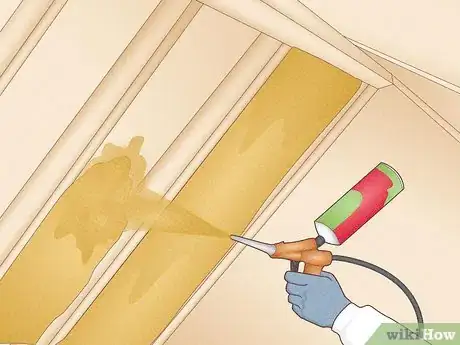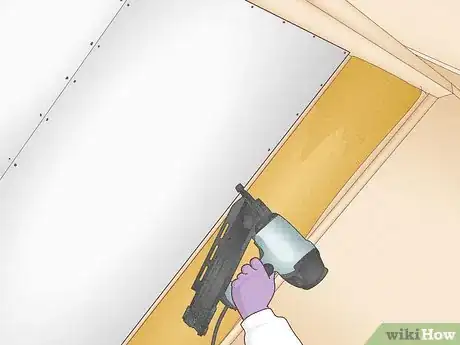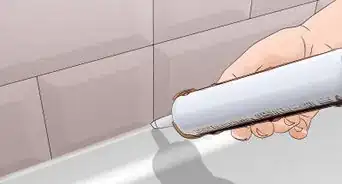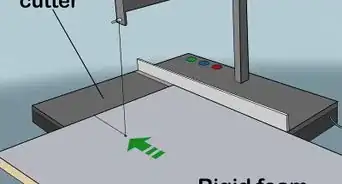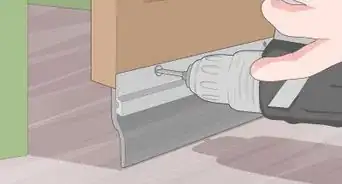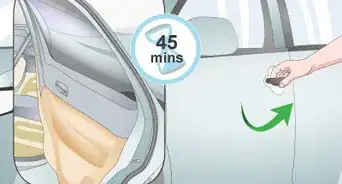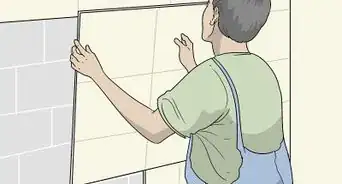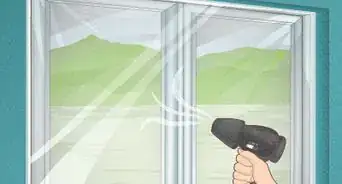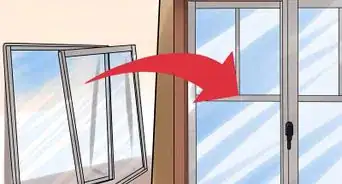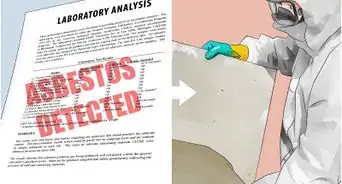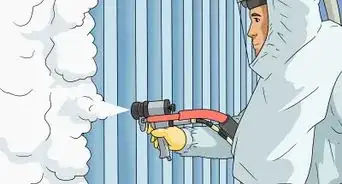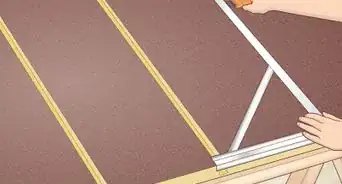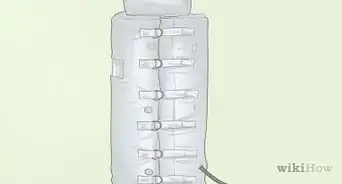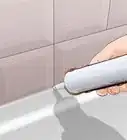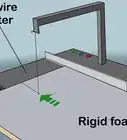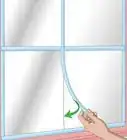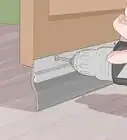This article was co-authored by Kevin Schlosser. Kevin Schlosser is a Home Improvement Specialist and the Owner of Home Tech Handyman Ltd. With over 20 years of experience, Kevin specializes in age-in-place installations, flooring, roofing, and general remodeling handyman services. Kevin holds a blend of construction and in-home technology-related certifications including NAHB Certified Age-in-Place Specialist, CEDIA membership and certifications, and a Certification from the Association of Certified Handyman Professionals. Also, he is in training to receive certifications in Construction, Project Management, and other CEDIA qualified system integrator certifications. He is fully-insured in the state of Colorado.
There are 8 references cited in this article, which can be found at the bottom of the page.
wikiHow marks an article as reader-approved once it receives enough positive feedback. In this case, several readers have written to tell us that this article was helpful to them, earning it our reader-approved status.
This article has been viewed 204,535 times.
Installing insulation in your walls during the process of building or renovating a house increases the energy efficiency of the building, which saves money on heating and cooling. Insulation also helps to buffer sound. Whether you want to use spray or fiberglass insulation batting, the proper steps and techniques are easy for the DIYer to learn, so you can do the job properly.
Steps
Installing Fiberglass Insulation
-
1Measure the total area of the walls to be insulated. Before you buy fiberglass insulation batting, you need to find out how much you'll need. To do this, you'll need to take measurements of the total area of the individual walls to be insulated, and also the width of the space between the studs.[1] Count up the number of wall gaps you have that need insulation and buy insulation batts accordingly.
- For the most part, studs will be built at uniform spacing, and batting is manufactured to fill those gaps. It should be the perfect width. Still, it's a good idea to count up the number of spaces you have and take a measurement to make sure you don't come home with the wrong size.
-
2Choose fiberglass insulation batting. The grade of batting will vary, depending on the wall that you’re insulating. There are various grades of insulating batting for different locations in the house, so you'll need a different insulation for interior, exterior, attic or basement walls.[2]
- The R-value of the batt measures the thermal resistance, so the higher the R-value, the more effectively the batt insulates.[3]
Typically, for interior walls, R-13 batts are used for 2 x 4 studs and R-19 batts are used for 2 x 6 studs.
- Note there are two R-value scales; US customary and metric. The US scale is approximately 5.68 times the metric scale, so R-13 in the US is equivalent to R-2.3 elsewhere.
- You'll also need to choose between faced batts, which have a paper "face" on one side that will cover the insulation to the outside, and un-faced batts, which are just the fiberglass.
Advertisement - The R-value of the batt measures the thermal resistance, so the higher the R-value, the more effectively the batt insulates.[3]
Typically, for interior walls, R-13 batts are used for 2 x 4 studs and R-19 batts are used for 2 x 6 studs.
-
3Consider “greener” alternatives. While fiberglass is actually up to 40 percent recycled material, there’s still a common complaint about the health-risks regarding airborne fibers of spun glass in your living space. Fiberglass is safe and the most inexpensive form of insulation, but it’s certainly not the only kind.[4] You might consider alternatives, like:
- Cotton. Recycled denim is regularly turned into a kind of insulation that's quite effective, and without the microfiber air problems that some people complain about with fiberglass.
- Mineral and sheep wool, cementitious, and cellulose-based insulation's are also common alternatives to fiberglass.
- You need to only use materials that have a thermal resistance rating. Insulating with things like egg crates and other recycled materials is a dangerous practice that can result in a fire.
-
4Get other tools necessary to complete the job. To install fiberglass or other insulating strips into your walls, you'll just need a few basic tools and the proper safety equipment. Make sure you've got:
- A staple gun
- Utility knife
- Protective gear (gloves, mask, long sleeves and pants)[5]
-
5Cut batts to the appropriate height. You should have purchased insulation of the appropriate width, but you'll have to cut it to size for every space you want to fill, in terms of height. Lay the insulation out, then carefully use your utility knife to cut through the face (if you've purchased faced insulation). It's kind of hard to cut through the insulation itself, which has the consistency of tenacious cotton candy, but you can pull it apart once you get it started.
- When you get your insulation home, keep it wrapped up until you're ready to use it. Cutting fiberglass insulation sends lots of little fiberglass particulate up into the air, which can cause allergic reactions and breathing problems. It's also extremely itchy, and can cause rashes in some people with sensitive skin. Never touch fiberglass batting with your bare hands and always wear breathing equipment when handling it.
- If you come into contact with fiberglass insulation, don’t scrub your hands or face with water, which can cause micro-abrasions. Dust yourself off outside and wash your clothes immediately.
-
6Push each batt into the gap between each stud. When you get it cut, just shove it in to the space, with the face pointing back outward, if you're using it. Try to handle it by the edges as much as possible, to keep the floating particles down. Gently tug each batt outward so it fills the gap entirely.[6]
-
7Secure the lip of the batting to each stud. Use your staple gun to secure the paper lining to the stud, roughly every 7 inches (17.8 cm). It's helpful to have an assistant hold the insulation in place, if necessary. Staple each piece securely, then move on to the next row.
- If you're looking for sound-dampening, it's a good idea to apply a thin line of caulk between the top plates, at the bottom plate, and around the floor of each batt. This will create a more secure seal that will keep sound from coming through.
-
8Apply vapor-retardant poly film over batting for exterior walls. To make external walls extremely insulated, it's common to apply a layer of vapor-retardant film over the insulation, to make it more secure. This will help to maximize the insulating potential of the batting, and you can find this at most home retailers.
- To install, you'll simply pull the film tight over the batting, stapling to the studs every foot or so, with the staple gun. Trim the excess with the utility knife.
Adding Spray Foam Insulation
-
1Make sure you have a suitable space for spray foam. If you want to insulate an area in your crawl space, attic, or basement, spray foam insulation might be appropriate for the job, using a low-pressure sprayer and the proper safety equipment.
- For the most part, roofs and other major renovation jobs require a lot of spray foam to insulate, meaning that it would probably be more cost effective to hire professional insulators with a spray rig, high-pressure applicators, and safety gear.
- Use spray cans of insulation for small jobs, like gaps between windows and doors, around dryer vents, fan outlets, and other plumbing. Spray cans are good for fixing small leaks, but not cost effective for insulating a wall.
-
2Get a low-pressure sprayer. Generally, disposable and refillable spray insulation tanks are sold as part of a spray foam insulation kit. It's not cheap, but you'll be able to quickly and easily insulate a small area. Each manufacturer will vary slightly in its
- You'll also need protective equipment. This means you'll need eye protection and a respirator.[7] A full work suit would be ideal, but long sleeves and pants will also do in a pinch.
-
3Choose between open and closed-cell insulation spray. Closed-cell insulation is rigid and dense, with a higher R-Value than open-cell. Most closed-cell spray is rated around 6.6, with open-cell insulation rated around 3.9. The advantage of open-cell is that it's super-fast and cheap, included in most individual small spray cans of foam.
- In wall-insulation, small holes are usually made in the drywall, into which the sprayer nozzle is inserted to fill the cavity with the spray inside the wall. For this method, open-cell is most often used, especially for ceilings and interior walls. It's sound-proof and used in the same locations as fiberglass. Closed-cell is usually used on external walls.
-
4Prepare the area for insulation. Remove exposed nails, debris, and other impediments from the walls to be insulated. Identify drafting areas–seams where you feel air leaking, see daylight, or see a gap. Mark these areas with tape, or a pen to make sure you address them with the insulation.
- It's a good idea to cover nearby furniture or finished flooring with plastic tarp to avoid getting any of the insulation on it. It's difficult to get out.
- It's best to apply spray insulation when the temperature is between 60 and 80 degrees F.
-
5Apply the spray from about two feet away. Attach your sprayer to the canister or bucket of insulation and start spraying, as if you were washing a window or car. Don't get too close, but stand a few feet back and spray as evenly as you can, back and forth across the area to be insulated. If you're spraying inside a wall, count to three, then stop and examine your progress to make sure that you aren't over-filling the wall.
- Insulation needs to be kept in a layer no deeper than an inch. Over-applying foam insulation can stress the walls and can also clump up and fall off the surface.
- If you miss, or get insulation somewhere you don't want it, don't panic. Stop and allow the insulation to dry and scrape it off the surface with a putty knife later. Trying to smear it now will make it worse.
- If you need to add multiple layers, because you're spraying an external wall or want extra sound-proofing, wait until the first layer has dried before going back over it as you did before. This will build up the R-Value of the insulation accordingly, and should stick perfectly well.
-
6Fire-sheath spray-insulated walls. Spray foam is not a finished surface and will ignite quickly in the event of a fire. After applying, it's common to drywall over the insulated area to finish the job.[8]
Expert Q&A
Did you know you can get expert answers for this article?
Unlock expert answers by supporting wikiHow
-
QuestionHow do you cut rigid foam insulation?
 Lui ColmenaresLui Colmenares is a handyman and licensed home improvement contractor for Mr. Handy NYC based in New York City, New York. Lui is trained and educated as an industrial engineer and specializes in carpentry, painting, and general handyman work such as mounting TVs, doorknob and deadbolt installation, furniture assembly, tile repair, and grouting. Mr. Handy NYC prides itself on quality work performed with speed, skill, and punctuality.
Lui ColmenaresLui Colmenares is a handyman and licensed home improvement contractor for Mr. Handy NYC based in New York City, New York. Lui is trained and educated as an industrial engineer and specializes in carpentry, painting, and general handyman work such as mounting TVs, doorknob and deadbolt installation, furniture assembly, tile repair, and grouting. Mr. Handy NYC prides itself on quality work performed with speed, skill, and punctuality.
Handyman
-
QuestionHow do you cut foam or soft insulation?
 Lui ColmenaresLui Colmenares is a handyman and licensed home improvement contractor for Mr. Handy NYC based in New York City, New York. Lui is trained and educated as an industrial engineer and specializes in carpentry, painting, and general handyman work such as mounting TVs, doorknob and deadbolt installation, furniture assembly, tile repair, and grouting. Mr. Handy NYC prides itself on quality work performed with speed, skill, and punctuality.
Lui ColmenaresLui Colmenares is a handyman and licensed home improvement contractor for Mr. Handy NYC based in New York City, New York. Lui is trained and educated as an industrial engineer and specializes in carpentry, painting, and general handyman work such as mounting TVs, doorknob and deadbolt installation, furniture assembly, tile repair, and grouting. Mr. Handy NYC prides itself on quality work performed with speed, skill, and punctuality.
Handyman
-
QuestionHow can I prevent issues with heat transfer when I'm using fiberglass insulation?
 Kevin SchlosserKevin Schlosser is a Home Improvement Specialist and the Owner of Home Tech Handyman Ltd. With over 20 years of experience, Kevin specializes in age-in-place installations, flooring, roofing, and general remodeling handyman services. Kevin holds a blend of construction and in-home technology-related certifications including NAHB Certified Age-in-Place Specialist, CEDIA membership and certifications, and a Certification from the Association of Certified Handyman Professionals. Also, he is in training to receive certifications in Construction, Project Management, and other CEDIA qualified system integrator certifications. He is fully-insured in the state of Colorado.
Kevin SchlosserKevin Schlosser is a Home Improvement Specialist and the Owner of Home Tech Handyman Ltd. With over 20 years of experience, Kevin specializes in age-in-place installations, flooring, roofing, and general remodeling handyman services. Kevin holds a blend of construction and in-home technology-related certifications including NAHB Certified Age-in-Place Specialist, CEDIA membership and certifications, and a Certification from the Association of Certified Handyman Professionals. Also, he is in training to receive certifications in Construction, Project Management, and other CEDIA qualified system integrator certifications. He is fully-insured in the state of Colorado.
Home Improvement Specialist
Warnings
- Do not pull on or stretch the facing paper as you staple the batts. This can cause gaps between the batt and stud on the opposite side.⧼thumbs_response⧽
- Do not install fiberglass insulation without wearing the proper protective gear. Use a dust mask to prevent inhalation of fiberglass and other particles, use goggles to shield your eyes, and wear gloves and a long-sleeved shirt to avert itchiness caused by fiberglass contact on the skin.⧼thumbs_response⧽
Things You'll Need
- Faced or non-faced fiberglass insulation batts
- Tape measure
- Utility knife
- Staples
- Staple gun
- Dust mask
- Goggles
- Gloves
- Long clothing
References
- ↑ https://www.lowes.com/n/how-to/install-insulation
- ↑ https://www.lowes.com/n/how-to/install-insulation
- ↑ Kevin Schlosser. Home Improvement Specialist. Expert Interview. 19 February 2021.
- ↑ http://www.thisoldhouse.com/toh/article/0,,1130563-2,00.html
- ↑ https://www.popularmechanics.com/home/how-to/a17349/fiberglass-insulation-tips/
- ↑ https://www.thisoldhouse.com/how-to/how-to-install-fiberglass-insulation
- ↑ https://www.thisoldhouse.com/how-to/do-it-yourself-spray-foam
- ↑ https://polyurethane.americanchemistry.com/WorkArea/DownloadAsset.aspx?id=2147484306
- http://www.thisoldhouse.com/toh/how-to/intro/0,,20431068,00.html
About This Article
Before insulating your walls with fiberglass insulation, measure the walls and the width between the studs to figure out how much batting you’ll need to purchase. Once you’ve purchased your insulation, put on protective gear, including gloves and a face mask, and cut your batts to the appropriate height. Then, push each batt into the gaps between the studs and secure it to the studs with a staple gun. Finally, apply a layer of vapor-retardant poly film over the insulation to maximize the insulating potential of the batting. To learn more, including how to insulate your walls with spray foam insulation, scroll down.
